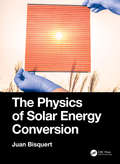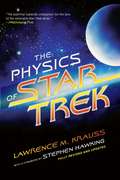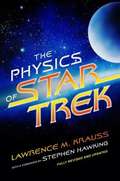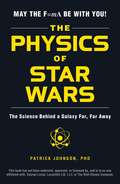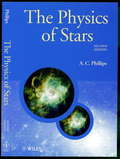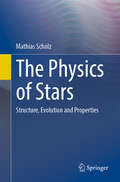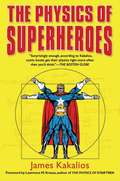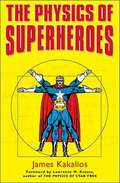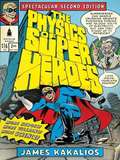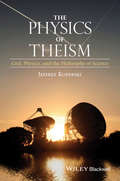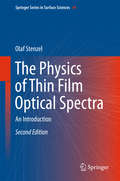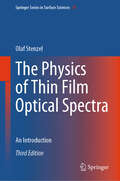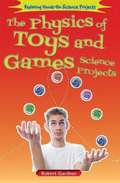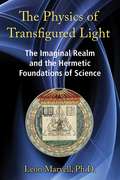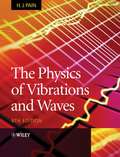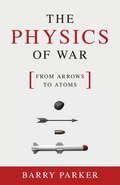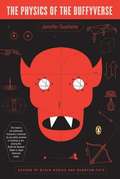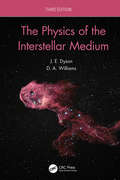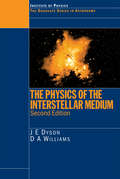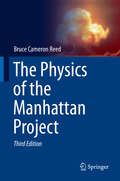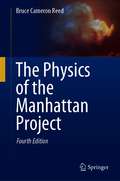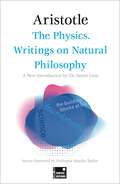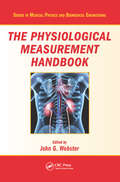- Table View
- List View
The Physics of Solar Energy Conversion: Perovskites, Organics, and Photovoltaic Fundamentals
by Juan BisquertResearch on advanced energy conversion devices such as solar cells has intensified in the last two decades. A broad landscape of candidate materials and devices were discovered and systematically studied for effective solar energy conversion and utilization. New concepts have emerged forming a rather powerful picture embracing the mechanisms and limitation to efficiencies of different types of devices. The Physics of Solar Energy Conversion introduces the main physico-chemical principles that govern the operation of energy devices for energy conversion and storage, with a detailed view of the principles of solar energy conversion using advanced materials. Key Features include: Highlights recent rapid advances with the discovery of perovskite solar cells and their development. Analyzes the properties of organic solar cells, lithium ion batteries, light emitting diodes and the semiconductor materials for hydrogen production by water splitting. Embraces concepts from nanostructured and highly disordered materials to lead halide perovskite solar cells Takes a broad perspective and comprehensively addresses the fundamentals so that the reader can apply these and assess future developments and technologies in the field. Introduces basic techniques and methods for understanding the materials and interfaces that compose operative energy devices such as solar cells and solar fuel converters.
The Physics of Star Trek
by Lawrence M. Krauss Lawrence KraussWhat warps when you’re traveling at warp speed? What is the difference between a wormhole and a black hole? Are time loops really possible, and can I kill my grandmother before I am born? Anyone who has ever wondered "could this really happen?” will gain useful insights into the Star Trek universe (and, incidentally, the real world of physics) in this charming and accessible guide. Lawrence M. Krauss boldly goes where Star Trek has gone-and beyond. From Newton to Hawking, from Einstein to Feynman, from Kirk to Picard, Krauss leads readers on a voyage to the world of physics as we now know it and as it might one day be.
The Physics of Star Trek
by Lawrence M. KraussLawrence M. Krauss boldly goes where Star Trek has gone--and beyond. <P><P>From Newton to Hawking, from Einstein to Feynman, from Kirk to Picard, Krauss leads readers on a voyage to the world of physics as we now know it and as it might one day be.
The Physics of Star Wars: The Science Behind a Galaxy Far, Far Away
by Patrick JohnsonExplore the physics behind the world of Star Wars, with engaging topics and accessible information that shows how we’re closer than ever before to creating technology from the galaxy far, far away—perfect for every Star Wars fan! Ever wish you could have your very own lightsaber like Luke Skywalker and Obi-Wan Kenobi? Or that you could fly through space at the speed of light like Han Solo and Poe Dameron? Well, those ideas aren’t as outlandish as you think. In The Physics of Star Wars, you’ll explore the mystical power of the Force using quantum mechanics, find out how much energy it would take for the Death Star or Starkiller Base to destroy a planet, and discover how we can potentially create our very own lightsabers. The fantastical world of Star Wars may become a reality!
The Physics of Stars (Manchester Physics Series)
by A. C. PhillipsThe Physics of Stars, Second Edition, is a concise introduction to the properties of stellar interiors and consequently the structure and evolution of stars. Strongly emphasising the basic physics, simple and uncomplicated theoretical models are used to illustrate clearly the connections between fundamental physics and stellar properties. This text does not intend to be encyclopaedic, rather it tends to focus on the most interesting and important aspects of stellar structure, evolution and nucleosynthesis. In the Second Edition, a new chapter on Helioseismology has been added, along with a list of physical constants and extra student problems. There is also new material on the Hertztsprung-Russell diagram, as well as a general updating of the entire text. It includes numerous problems at the end of each chapter aimed at both testing and extending student's knowledge.
The Physics of Stars: Structure, Evolution and Properties
by Mathias ScholzInterested students in the natural and engineering sciences, as well as high school graduates, instructors, teachers, and amateur astronomers, will find a valuable overview of the physics of stars in this book. The only prerequisite is a basic mathematical and physical background, which does not go beyond the knowledge of integral and differential calculus. In this regard, this book aims to bridge the gap with the specialized literature available on the internet, allowing readers to benefit from it. The first part traces the historical development that led to a detailed understanding of the nature of stars and their life cycles. The goal of the following chapters is to provide a pragmatic introduction to the physical processes that determine the structure and evolution of stars based on their fundamental parameters such as mass and chemical composition. It will show what can be learned from the analysis of starlight about stellar atmospheres, the fundamental role of the virial theorem in the lives of stars, and the nuclear processes deep inside stars that provide the energy that makes them shine. Finally, there will be an in-depth phenomenological look at the final stages of stellar evolution. This section will discuss states of matter that are far from experimental realization but whose properties can be, at least in principle, inferred from the observation of concrete objects such as white dwarfs or neutron stars. Exciting developments are still expected in this area in the future. Mathias Scholz is hobby astronomer. He studied physics at the University of Rostock from 1981 to 1986. Interested students in the natural and engineering sciences, as well as high school graduates, instructors, teachers, and amateur astronomers, will find a valuable overview of the physics of stars in this book. The only prerequisite is a basic mathematical and physical background, which does not go beyond the knowledge of integral and differential calculus. In this regard, this book aims to bridge the gap with the specialized literature available on the internet, allowing readers to benefit from it. The first part traces the historical development that led to a detailed understanding of the nature of stars and their life cycles. The goal of the following chapters is to provide a pragmatic introduction to the physical processes that determine the structure and evolution of stars based on their fundamental parameters such as mass and chemical composition. It will show what can be learned from the analysis of starlight about stellar atmospheres, the fundamental role of the virial theorem in the lives of stars, and the nuclear processes deep inside stars that provide the energy that makes them shine. Finally, there will be an in-depth phenomenological look at the final stages of stellar evolution. This section will discuss states of matter that are far from experimental realization but whose properties can be, at least in principle, inferred from the observation of concrete objects such as white dwarfs or neutron stars. Exciting developments are still expected in this area in the future.
The Physics of Superheroes
by James KakaliosWhat did the Flash know about the Special Theory of Relativity that you do not? Why did Ant-Man have so much difficulty with a half-filled bathtub? Kakalios combines his love for comic books and the startling accurate ways they present physics with his love of explaining physics to undergraduates and those of us destined to never get beyond the comic book stage. While filling us in on why spending your allowance on x-ray glasses is a poor investment, Kakalios covers mechanics (including Newton's Law of Gravity, the properties of matter and the cube-square law) energy (including conservation and Ampere's Law), and modern physics (including quantum mechanics, solid-state physics and tunneling phenomena). In a final section, Kakalios also contemplates a series of superhero bloopers, proving that sometimes having mutant powers and three bucks is only good for a small cappuccino.
The Physics of Superheroes
by James KakaliosA complete update to the hit book on the real physics at work in comic books, featuring more heroes, more villains, and more science Since 2001, James Kakalios has taught "Everything I Needed to Know About Physics I Learned from Reading Comic Books," a hugely popular university course that generated coast-to-coast media attention for its unique method of explaining complex physics concepts through comics. With The Physics of Superheroes, named one of the best science books of 2005 by Discover, he introduced his colorful approach to an even wider audience. Now Kakalios presents a totally updated, expanded edition that features even more superheroes and findings from the cutting edge of science. With three new chapters and completely revised throughout with a splashy, redesigned package, the book that explains why Spider-Man's webbing failed his girlfriend, the probable cause of Krypton's explosion, and the Newtonian physics at work in Gotham City is electrifying from cover to cover. .
The Physics of Superheroes: Spectacular Second Edition
by James KakaliosA complete update to the hit book on the real physics at work in comic books, featuring more heroes, more villains, and more science Since 2001, James Kakalios has taught "Everything I Needed to Know About Physics I Learned from Reading Comic Books," a hugely popular university course that generated coast-to-coast media attention for its unique method of explaining complex physics concepts through comics. With The Physics of Superheroes, named one of the best science books of 2005 by Discover, he introduced his colorful approach to an even wider audience. Now Kakalios presents a totally updated, expanded edition that features even more superheroes and findings from the cutting edge of science. With three new chapters and completely revised throughout with a splashy, redesigned package, the book that explains why Spider-Man's webbing failed his girlfriend, the probable cause of Krypton's explosion, and the Newtonian physics at work in Gotham City is electrifying from cover to cover.
The Physics of Theism
by Jeffrey KoperskiThe Physics of Theism provides a timely, critical analysis of the ways in which physics intertwines with religion. Koperski brings clarity to a range of arguments including the fine-tuning argument, naturalism, the laws of nature, and the controversy over Intelligent Design.A single author text providing unprecedented scope and depth of analysis of key issues within the Philosophy of Religion and the Philosophy of ScienceCritically analyses the ways in which physics is brought into play in matters of religionSelf-contained chapters allow readers to directly access specific areas of interestThe area is one of considerable interest, and this book is a timely and well-conceived contribution to these debatesWritten by an accomplished scholar working in the philosophy of physics in a style that renders complex arguments accessible
The Physics of Thin Film Optical Spectra
by Olaf StenzelThe book bridges the gap between fundamental physics courses (such as optics, electrodynamics, quantum mechanics and solid state physics) and highly specialized literature on the spectroscopy, design, and application of optical thin film coatings. Basic knowledge from the above-mentioned courses is therefore presumed. Starting from fundamental physics, the book enables the reader derive the theory of optical coatings and to apply it to practically important spectroscopic problems. Both classical and semiclassical approaches are included. Examples describe the full range of classical optical coatings in various spectral regions as well as highly specialized new topics such as rugate filters and resonant grating waveguide structures. The second edition has been updated and extended with respect to probing matter in different spectral regions, homogenous and inhomogeneous line broadening mechanisms and the Fresnel formula for the effect of planar interfaces.
The Physics of Thin Film Optical Spectra: An Introduction (Springer Series in Surface Sciences #74)
by Olaf StenzelThis book serves as a comprehensive guide to the physics of thin-film optical spectra, bridging the gap between fundamental physics courses, such as optics, electrodynamics, quantum mechanics, and solid-state physics, and the highly specialized literature on the spectroscopy, design, and application of optical thin film coatings. It presumes a basic understanding from these courses and builds upon it. Starting from the fundamentals of physics, the book equips the reader with the ability to derive the theory of optical coatings and apply it to significant spectroscopic problems. It encompasses both classical and semiclassical approaches. The topics covered range from classical optical coatings in various spectral regions to more specialized areas such as rugate filters and ultrafast mirrors. The expanded and updated third edition places a stronger emphasis on basic physical modeling aspects and updates the description of nonlinear coating properties. Additionally, it includes an expanded collection of problems with detailed solutions and explanations, enhancing the reader’s understanding and application of the concepts.
The Physics of Toys and Games Science Projects
by Robert GardnerCan you figure out how cars loop-the-loop and defy gravity? Can you throw a curve with a beach ball? Would you like to be able to determine the thickness of a soap bubble? The science experiments in this book will help you learn about gravity, friction, electrical charges, and more. The ideas introduced in this book, along with details of the scientific method, will help you to perform challenging, educational, and fun science fair projects! The Physics of Toys and Games Science Projects Book jacket.
The Physics of Transfigured Light: The Imaginal Realm and the Hermetic Foundations of Science
by Arthur Versluis Leon MarvellReveals the Hermetic underpinnings of modern scientific theories • Offers a full reconsideration of the history of science from Newton to the present day as well as a Platonic-Hermetic perspective on modern technology • Examines Hermetic resonances among the ideas of Gurdjieff, Robert Fludd, Marsilio Ficino, and cybernetics; Einstein and the Tibetan Bardo; Neoplatonism and artificial intelligence; and Rosicrucianism and the internet • Shows how Hermetic doctrine is at the heart of what modern physics is now rediscovering: that consciousness permeates everything Contemporary scientific disciplines such as chaos and complexity theory, artificial intelligence, and cognitive science treat themselves as new fields of inquiry, but many of these ideas can be traced back to Hermeticism, the European intellectual tradition sparked by the rediscovery of the Corpus Hermeticum and Platonic texts in the 15th century. Building a map of the progression of scientific thought across centuries and continents, Leon Marvell examines the ancient roots of Hermeticism, its rise during the Renaissance, and its suppression during the scientific revolution of the Enlightenment. He reveals how three main Hermetic ideas--the divine spark within each individual, the subtle body, and the anima mundi or world soul--have continually emerged at the cutting edge of science and philosophy throughout the ages because these ideas represent universal truths recognized by each era of human civilization. Marvell examines Hermetic resonances among the ideas of Gurdjieff, Robert Fludd, Marsilio Ficino, and cybernetic theory; Einstein and the Tibetan Bardo; and Neoplatonism and the work of AI scientist Christopher Langton. He reveals how the Rosicrucian description of the Invisible College also describes the instant availability of knowledge via the Internet, and he shows how Hermetic thought is at the heart of what modern physics is rediscovering: that consciousness permeates everything and the universe cannot be reduced to the random play of matter. Offering a full reconsideration of the history of science from Newton to the present day as well as a Platonic-Hermetic perspective on modern technology, Marvell reveals the pattern that connects the sciences, philosophy, and ancient knowledge and opens a potentially rich field of inquiry for 21st-century science.
The Physics of Vibrations and Waves
by H. J. PainThe main theme of this highly successful book is that the transmission of energy by wave propogation is fundamental to almost every branch of physics. Therefore, besides giving students a thorough grounding in the theory of waves and vibrations, the book also demonstrates the pattern and unity of a large part of physics.This new edition has been thoroughly revised and has been redeisgned to meet the best contemporary standards. It includes new material on electron waves in solids using the Kronig-Penney model to show how their allowed energies are limited to Brillouin zones, The role of phonons is also discussed. An Optical Transform is used to demonstrate the modern method of lens testing. In the last two chapters the sections on chaos and solitons have been reduced but their essential contents remain.As with earlier editions, the book has a large number of problems together with hints on how to solve them. The Physics of Vibrations and Waves, 6th Edition will prove invaluable for students taking a first full course in the subject across a variety of disciplines particularly physics, engineering and mathematics.
The Physics of War
by Barry ParkerThis fascinating blend of popular science and military history examines the science of war, demonstrating the close connection between the discovery of basic physical principles and the development of weaponry over the ages. Physics has played a critical role in warfare since the earliest times. Barry Parker highlights famous battles of the past as well as renowned scientists and inventors such as Leonardo, Galileo, Newton, Maxwell, and Einstein whose work had an impact on the technology of combat. Mechanics and the laws of motion led to improved shell trajectories; gas dynamics proved important to the interior ballistics of rifles and cannons; and space exploration resulted in intercontinental missiles, spy satellites, and drone aircraft. Parker emphasizes the special discoveries that had revolutionary effects on the art of warfare: the Chinese invention of gunpowder, the development of firearms, the impact of the Industrial Revolution, the deployment of the airplane in the First World War, and in our era the unleashing of the enormous power inherent in nuclear fission and fusion.
The Physics of the Buffyverse
by Jennifer OuellettePhysics with a Buffy the Vampire Slayer pop-culture chaser In the tradition of the bestselling The Physics of Star Trek, acclaimed science writer Jennifer Ouellette explains fundamental concepts in the physical sciences through examples culled from the hit TV shows Buffy the Vampire Slayer and its spin-off, Angel. The weird and wonderful world of the Buffyverse-where the melding of magic and science is an everyday occurrence-provides a fantastical jumping-off point for looking at complex theories of biology, chemistry, and theoretical physics. From surreal vampires, demons, and interdimensional portals to energy conservation, black holes, and string theory, The Physics of the Buffyverse is serious (and palatable) science for the rest of us. .
The Physics of the Dark Photon: A Primer (SpringerBriefs in Physics)
by Marco Fabbrichesi Emidio Gabrielli Gaia LanfranchiThis book is about the dark photon which is a new gauge boson whose existence has been conjectured. Due to its interaction with the ordinary, visible photon, such a particle can be experimentally detected via specific signatures. In this book, the authors review the physics of the dark photon from the theoretical and experimental point of view. They discuss the difference between the massive and the massless case, highlighting how the two phenomena arise from the same vector portal between the dark and the visible sector. A review of the cosmological and astrophysical observations is provided, together with the connection to dark matter physics. Then, a perspective on current and future experimental limits on the parameters of the massless and massive dark photon is given, as well as the related bounds on milli-charged fermions. The book is intended for graduate students and young researchers who are embarking on dark photon research, and offers them a clear and up-to-date introduction to the subject.
The Physics of the Interstellar Medium
by J.E. Dyson D.A. WilliamsThis third edition of The Physics of the Interstellar Medium continues to introduce advanced undergraduates to the fundamental processes and the wide range of disciplines needed to understand observations of the interstellar medium and its role in the Milky Way galaxy. The book is suitable for undergraduate students studying physics, astronomy, and astrophysics. The book also provides concise and straightforward discussions of interstellar physics and chemistry that are useful for more experienced readers. The book leads readers through the range of physical processes operating on both large and small scales that occur in the interstellar medium. It explores the relationship between the dusty, tenuous gas in interstellar space and the formation of stars and planets. This new edition also describes exciting developments in the field of astrochemistry and its interaction with interstellar physics, and the roles played by interstellar dust grains in interstellar physics and chemistry. Simple models in each chapter, together with problems at the end of each chapter, encompass interdisciplinary applications in atomic, molecular, solid state, and surface physics, and gas dynamics. This popular textbook provides a useful overview and grounding in the study of the interstellar medium and brings insight into many aspects of physics. Features An authoritative textbook in the field at this academic level Provides a wide introduction to the interstellar medium whilst remaining accessible and concise Revised throughout, presenting a modern understanding of the interstellar medium
The Physics of the Interstellar Medium (Series in Astronomy and Astrophysics)
by J E Dyson D A WilliamsThe book leads the advanced undergraduate through the wide range of disciplines related to an understanding of the interstellar medium and is suitable for any student studying either physics or astrophysics. The study of the interstellar medium incorporates a large range of physical More...processes on both large and small scales all of which are covered in this text. Together with the inclusion of simple models and problems at the end of each chapter this text provides a comprehensive overview and grounding in the study of the interstellar medium.
The Physics of the Manhattan Project
by B. Cameron ReedThe development of nuclear weapons during the Manhattan Project is one of the most significant scientific events of the twentieth century. This book, prepared by a gifted teacher of physics, explores the challenges that faced the members of the Manhattan project. In doing so it gives a clear introduction to fission weapons at the level of an upper-level undergraduate physics student. Details of nuclear reactions, their energy release, the fission process, how critical masses can be estimated, how fissile materials are produced, and what factors complicate bomb design are covered. An extensive list of references and a number of problems for self-study are included. Links are given to several spreadsheets with which users can run many of the calculations for themselves.
The Physics of the Manhattan Project
by Bruce Cameron ReedThe development of nuclear weapons during the Manhattan Project is one of the most significant scientific events of the twentieth century. This revised and updated 3rd edition explores the challenges that faced the scientists and engineers of the Manhattan Project. It gives a clear introduction to fission weapons at the level of an upper-year undergraduate physics student by examining the details of nuclear reactions, their energy release, analytic and numerical models of the fission process, how critical masses can be estimated, how fissile materials are produced, and what factors complicate bomb design. An extensive list of references and a number of exercises for self-study are included. Links are given to several freely-available spread sheets which users can use to run many of the calculations for themselves.
The Physics of the Manhattan Project: How Nuclear Physics Became A Global Geopolitical Game-changer (Undergraduate Lecture Notes In Physics Ser.)
by Bruce Cameron ReedThe development of nuclear weapons during the Manhattan Project is one of the most significant scientific events of the twentieth century. This revised and updated 4th edition explores the challenges that faced the scientists and engineers of the Manhattan Project. It gives a clear introduction to fission weapons at the level of an upper-year undergraduate physics student by examining the details of nuclear reactions, their energy release, analytic and numerical models of the fission process, how critical masses can be estimated, how fissile materials are produced, and what factors complicate bomb design. An extensive list of references and a number of exercises for self-study are included. Revisions to this fourth edition include many upgrades and new sections. Improvements are made to, among other things, the analysis of the physics of the fission barrier, the time-dependent simulation of the explosion of a nuclear weapon, and the discussion of tamped bomb cores. New sections cover, for example, composite bomb cores, approximate methods for various of the calculations presented, and the physics of the polonium-beryllium "neutron initiators" used to trigger the bombs.The author delivers in this book an unparalleled, clear and comprehensive treatment of the physics behind the Manhattan project.
The Physics. Writings on Natural Philosophy (Foundations)
by AristotleAristotle's great work that laid the foundations for Galileo, Isaac Newton and Albert Einstein's much later discoveries about the natural laws of life and the universe.In the philosophical language of Aristotle and the Greeks of Antiquity, 'Physics' roughly translates as 'the order of nature', covering what we would now differentiate as philosophy, science, politics, humanities and religion. One of Aristotle's great works, of which we here present an abridged edition, The Physics is an investigation into the nature of being, of the world and its place in the universe. Although philosophically much broader, it provides the foundation for the later work of Galileo and Isaac Newton, and prefigures Albert Einstein's breakthrough theories on time, space and the motion of stars.The FLAME TREE Foundations series features core publications which together have shaped the cultural landscape of the modern world, with cutting-edge research distilled into pocket guides designed to be both accessible and informative.
The Physiological Measurement Handbook (Series in Medical Physics and Biomedical Engineering)
by John G. WebsterThe Physiological Measurement Handbook presents an extensive range of topics that encompass the subject of measurement in all departments of medicine. The handbook describes the use of instruments and techniques for practical measurements required in medicine. It covers sensors, techniques, hardware, and software as well as information on processin
